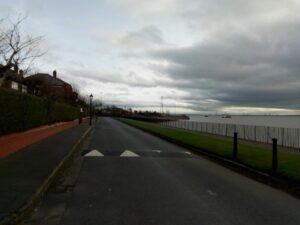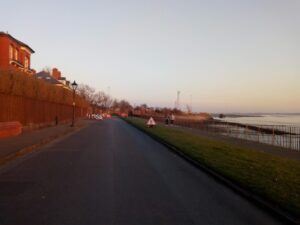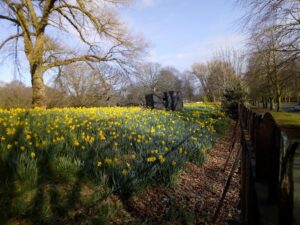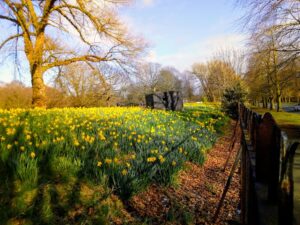Sefton Council, has done great work creating a walking and cycling accessible coastal path all the way from Hall Road on the edge of Liverpool via Hightown to Formby. In doing so it has either deliberately or through ignorance neglected or deliberately filled in important remains of the World War Two coastal defences that protected Liverpool Bay and the West Lancashire coast. If deliberate then this is a stupefying decision to almost literally cover over local history; if due to ignorance then it shows a stunning lack of local knowledge.
I grew up in Hightown a large commuter village on the coast a couple of miles outside of the continuous Liverpool conurbation. In the late 1970s, we played as children among the sand dunes where a new estate was being built, sand dunes that were still lined with concrete and barbed wire fences from World War II defences. Where we could freely wander into the Second World War bunkers, probably gun emplacements, maybe just air raid shelters between the dunes, West Lancs Golf Course, and the coast near the outflow pipe at the end of the small River Alt.
There are three emplacements still there, and inland what look like air raid shelters – pillboxes – in a couple of farmers’ fields, and another concrete defensive point at a small bridge over a brook a couple of miles north and inland at Little Altcar. Is this heritage preserved, explained, access provided, or simply maintained? It is ignored, completely as far as I can tell, and in the case of the dark, damp and dingy coastal bunkers we used to duck in and out of, they’ve been deliberately blocked up so that it is hard to tell what they were.
The photographs here are from 2009 (the dates have got jumbled up in transfer at some point) and a couple showing the site of two of the bunkers from December 2017. In the earlier photos Frances & Jules are standing on the rooves of the bunkers so you can see where they are and how hard they are to spot just from a few yards away. My, crouched by the entrance, shows the scale. The later photos show they are even harder to spot now, and I saw the entrances seem to have been filled in more.
These ‘bunkers’ are probably the coastal defence battery as described on Wikipedia (the first sentence quoting the entry on heritage gateway: “Listed as in poor condition (surveyed in 2000) is Coastal Battery S0011771 (Crosby Point Battery), between Coastguard Station and Hightown, north of Crosby. This is near the end of the West Lancs Golf Course, a mile south from Hightown station just off the footpath from Hall Road to Hightown. When Sefton Council upgraded the Sefton Coastal Footpath they blocked up two [actually three] gun emplacements that remained of the Fort Crosby site.” https://en.wikipedia.org/wiki/Hightown,_Merseyside
Ironically these bunkers used to be hidden slightly back in the dunes so one had to look to find them. Now they are exposed near the path but are less visible.
By contrast in Jersey (where they obviously have more unique for Britain war heritage), in Ireland, or in other countries I see more evidence that some sites and remnants are actually preserved and the memory kept.
The World War II remains are listed in the various databases, it seems heritage is preserved quite well digitally, but not in reality. Three World War Two invasion defence pillboxes can be seen near Gorsey Lane and are listed in the database, each as: Type 23 World War II concrete pillbox, constructed in the period 1940 to 1941. These are found in the Defence of Britain Archive of the Council for British Archaeology, 2002.
Each feature is listed on the Heritage Gateway / Pastscape database
Crosby Point Coastal Battery and its history is recorded here:
http://www.pastscape.org.uk/hob.aspx?hob_id=1425941
Clicking on related monuments give you the descriptions of others nearby, though which describe each one I am writing about I am not sure because I don’t know the precise locations.
One pillbox is here: http://www.pastscape.org.uk/hob.aspx?hob_id=1425940
It is a shame that the links to these various really useful and interesting sites are not more obvious on the front page or links of ‘Historic England’, the body formerly known as English Heritage. This page does enable you to search listed and many other heritage sites: https://historicengland.org.uk/listing/the-list/non-listed-sites/
But only of course in England, in our artificially divided island where official heritage maps, like traffic and transport information has to stop at arbitrary lines on a map between Wales, England and Scotland.
A Channel 4 programme, ‘Britain at Low Tide’ featured this section of coast in episode two in November 2016. http://www.channel4.com/programmes/britain-at-low-tide Channel 4 promoted the CITiZAN database and coastal archaeology survey app. https://citizan.org.uk/app/ Created by different partners, it uses a variety of sources including much information from Historic England’s databases. The map is easy to use and you can pull up the results around Hightown including the remnants I am talking about. Unfortunately, the Bing map base is not as useful for the coastal areas as looking at the Ordnance Survey maps that underlay the feature on the Historic England site. And the regular Ordnance Survey map does not show these features.
Note. http://www.heritagegateway.org.uk/gateway/
A search on a typical Hightown postcode set at 2km (to not only cover the built up settlement) brings up many results – quite a few in the historic villages of Ince Blundell and Little Crosby, but most of the entries listed are the sites of ships wrecked off the coast near Formby – there are 50 !! listed over the last 250 years.
I wrote about the same topic on this website, last year, here: https://kironreid.co.uk/2017/07/21/failure-to-preserve-world-war-2-heritage-in-nw-england/
‘Failure to preserve World War 2 heritage in NW England.’ 21 July 2017.
I’ve raised the issue several times since 2008, in 2010, 2011.
On a nearby preserving the past topic I’ve also tried to get local and heritage authorities interested about a small aspect of railways heritage. I’ll write about that next.




